The Michelin Guide began when the tire company — Michelin Tires — wanted to encourage travelers to drive to their destinations, in turn boosting car and tire sales. This helpful guide offered maps, attractions, and briefly mentioned places to stay and eat. The publication began as a travel guide to encourage day trips and now covers a range of prestigious ventures such as the flavor and personality of dishes at restaurants. Today, the coveted Michelin stars are awarded to the very best of the best restaurants.
According to The International Culinary Center, US-based restaurants only became eligible for Michelin stars in 2005, and the list continues to grow. The ratings range from one to three and rank the most sophisticated and successful restaurants around the world.
Bvlgari Hotels & Resorts is proud to announce that both the hotel’s signature restaurants, the Italian Il Ristorante — Niko Romito and the Chinese Bao Li Xuan, have been awarded Michelin stars during the Michelin Guide Shanghai 2020 presentation ceremony.
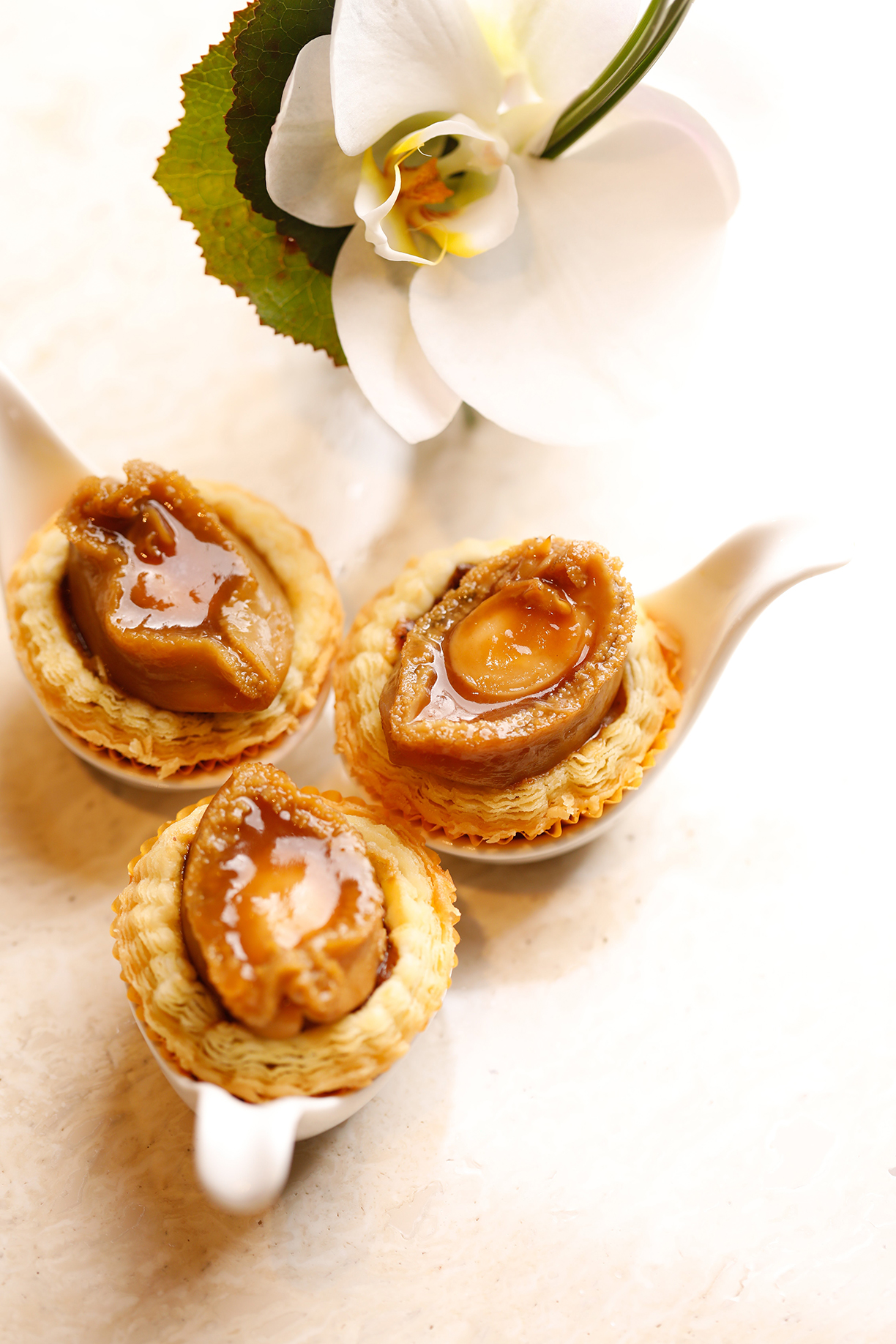
Bao Li Xuan — 1 Michelin Star
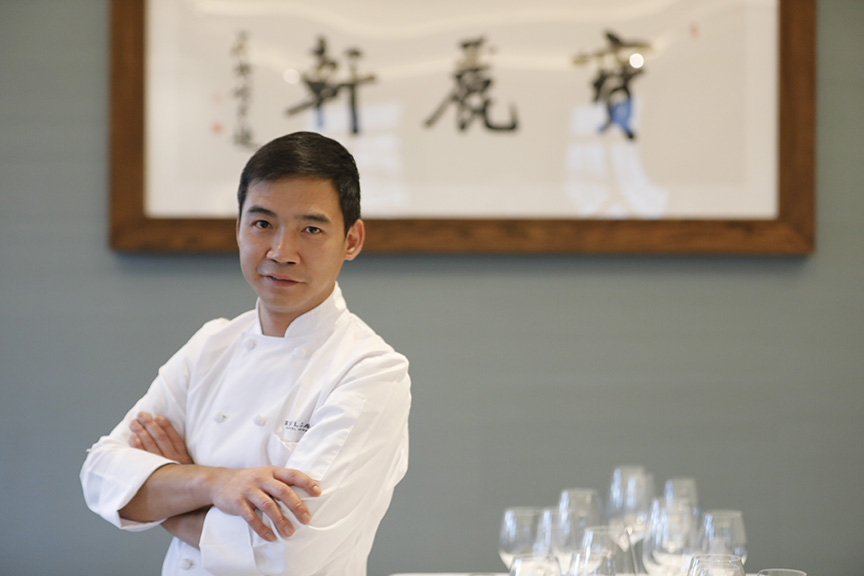
Located in Bvlgari Hotel Shanghai’s historic Chamber of Commerce Shanghai building, Bao Li Xuan will celebrate its first anniversary in October 2019. An enchanting blend of classic nostalgia and metropolitan modernity framed by its unique heritage setting dating back to 1916, the restaurant serves exquisite Cantonese cuisine prepared by Chef Fu from Hong Kong.
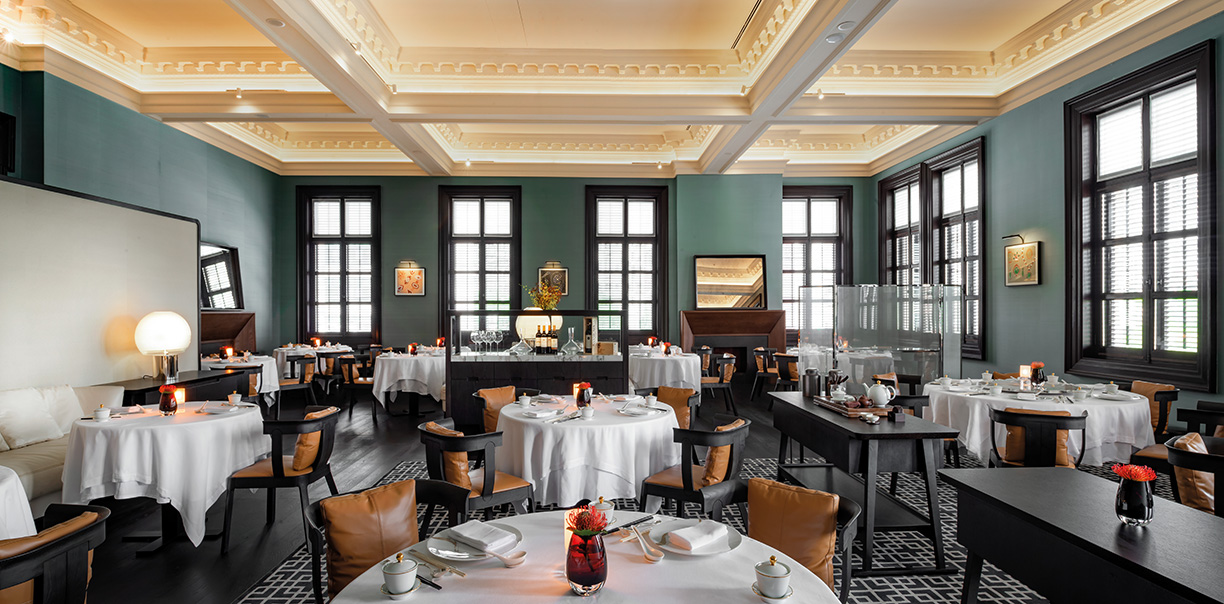
II Ristorante — Niko Romito — 1 Michelin Star
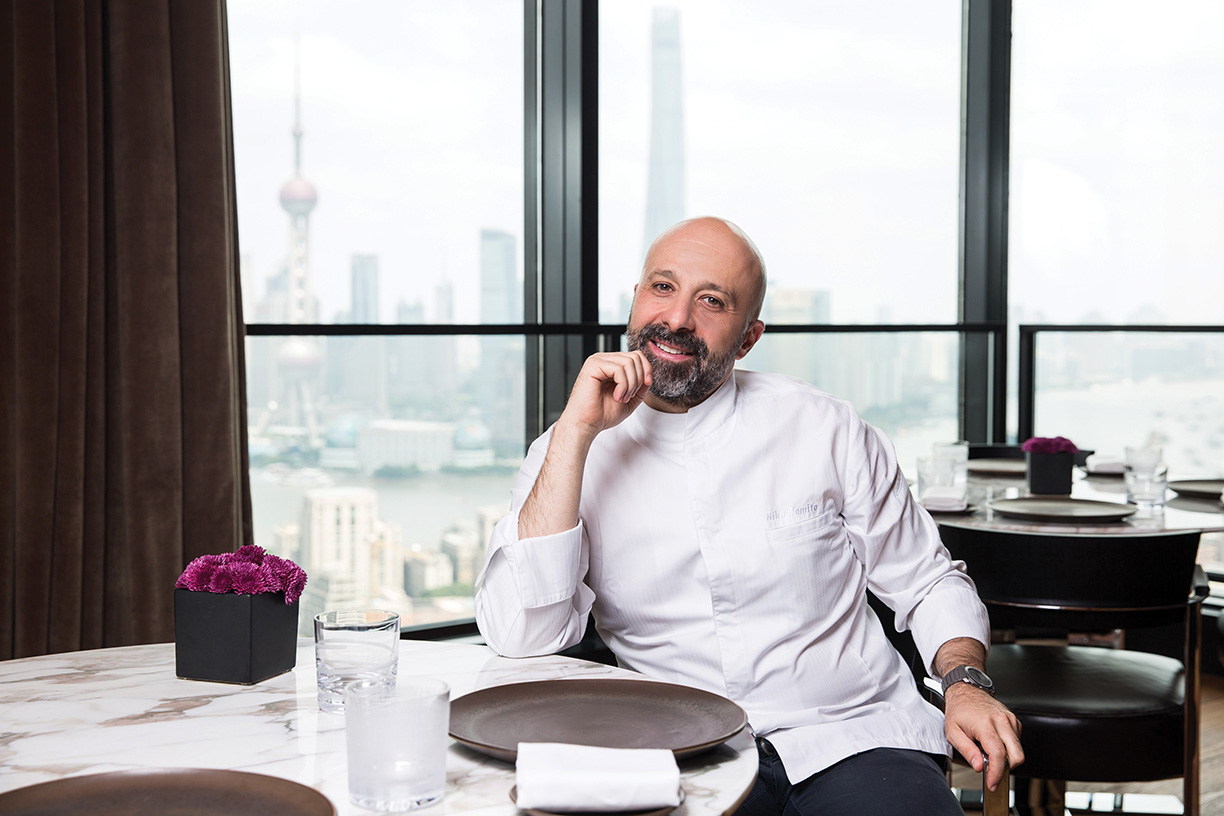
Il Ristorante — Niko Romito represents a unique collaboration between Bvlgari Hotels & Resorts and the renowned Italian chef-patron of 3 Michelin star restaurant Reale in Abruzzo. Showcasing a new gastronomic concept that the chef specially designed for Bvlgari Hotels & Resorts, Il Ristorante — Niko Romito is currently present in the Bvlgari properties of Dubai, Beijing, Shanghai, and Milan. Niko Romito is one of very few Michelin-awarded chefs in Italy to receive this prestigious acknowledgment by the Michelin Guide both in his home country and internationally.
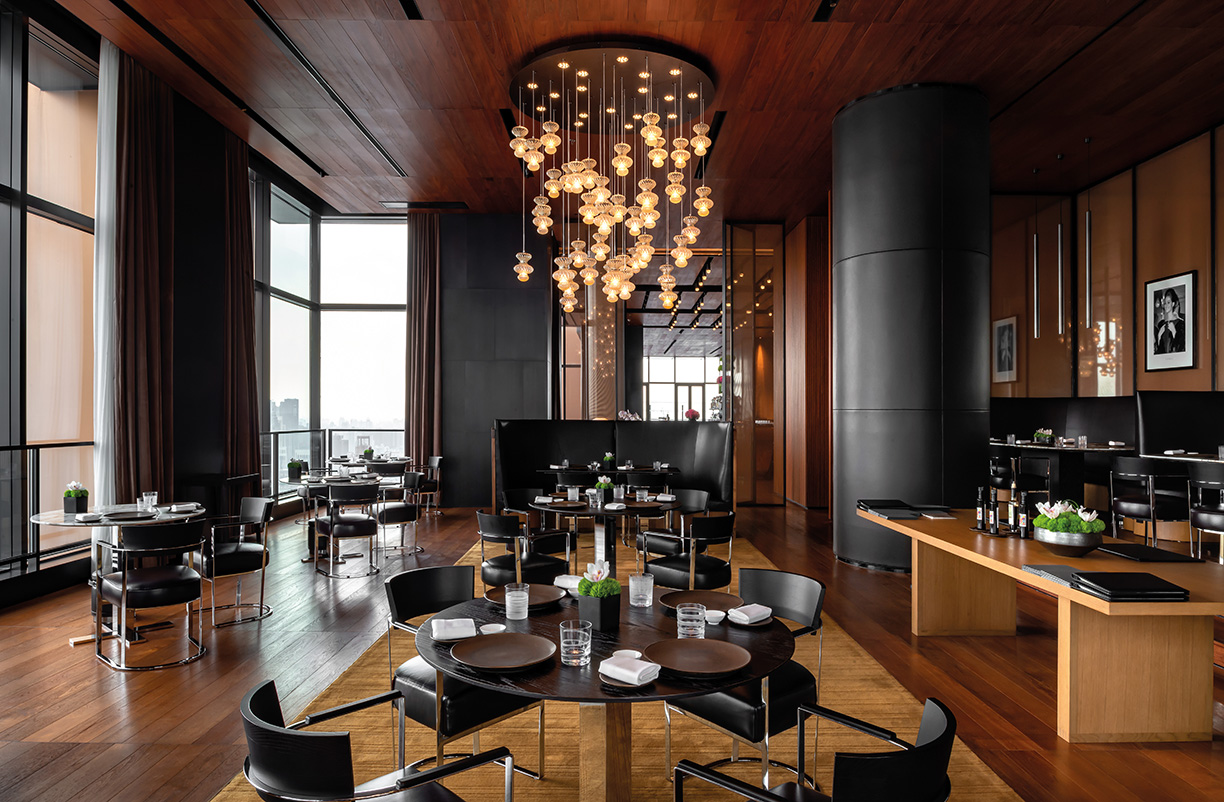
Other Michelin Rated Restaurants To Try
Michelin Rated Italian
Giovannelli (Kerry, Ireland) — Italian cuisine crafted from homemade pasta and fresh local herbs.
Crust (Phuket, Thailand) — A cozy setting for Italian classics, such as scallops with truffle risotto and tiramisu.
Hos Thea (Oslo, Norway) — This small but well-established Italian restaurant only used the freshest ingredients.
Michelin Rated Chinese
Daguan Noodle (Chicago, Illinois) — Chinese cuisine with a twist on comfort, think rice noodles and steaming bowls of broth.
Duck & Rice (London, England) — A converted pub serving delectable Chinese classics with fireplaces and booths for added comfort.
Wei Lou (Seoul, South Korea) — Located on the 34th floor of Grand InterContinental Seoul Parnas, the spacious venue, delectable favorites make it ideal for large gatherings.
Photos courtesy of Bvlgari Hotels & Resorts
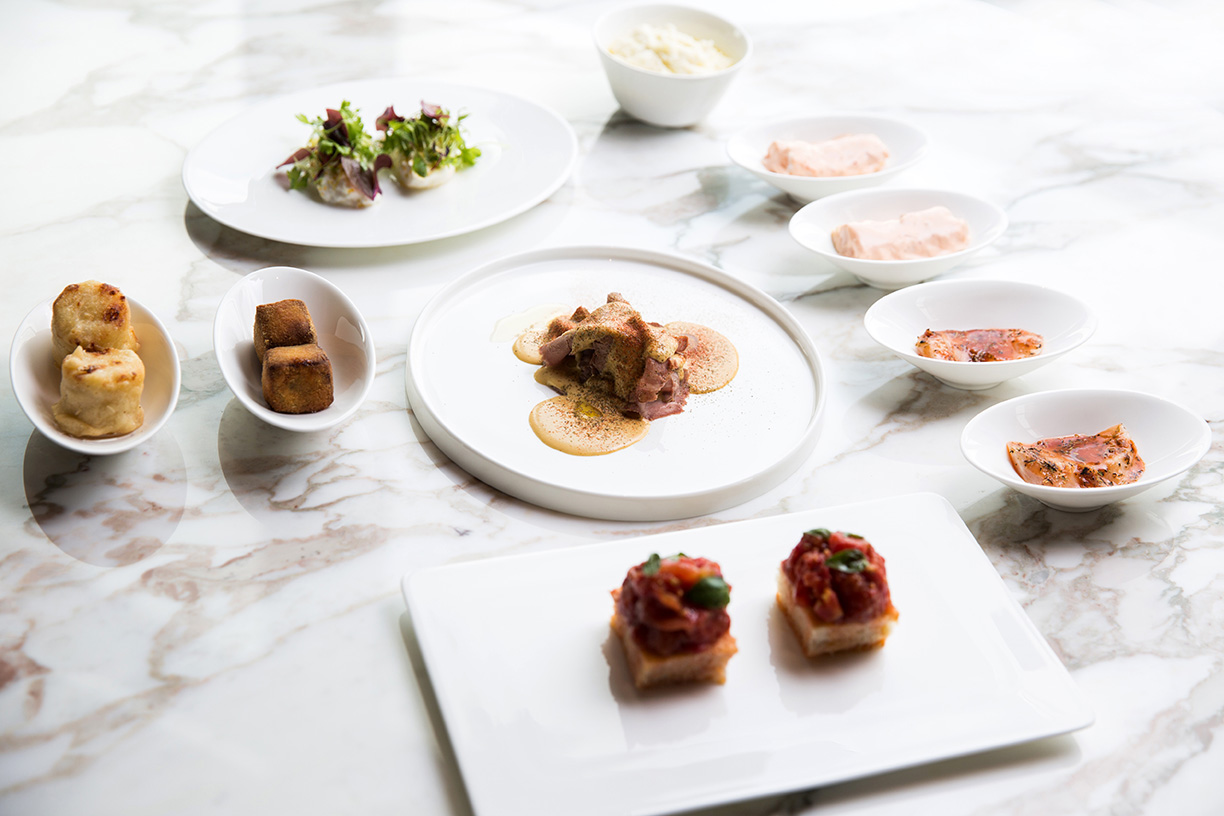
For similar content, try; Mainstream Middle Eastern, Cutting Edge, Catering to Today’s Food Trends, Gourmet Food Halls.
Once relegated to unpretentious mom-and-pop eateries, the diverse cuisine of the Middle East has graduated to sophisticated, award-winning restaurants across America.
Every Middle Eastern culture has its own food (some countries even have distinct local cuisines), but culinary boundaries are much more amorphous than national borders. Despite a surprising degree of cultural diversity, the region’s indigenous products — chickpeas, dates, pomegranates, saffron, and olive oil, to name a few — result in some universal themes, even among adversaries.
Additionally, the use of spices like turmeric, cumin, garlic and sumac contribute to consistencies from Israel to Turkey, Lebanon to Iran. The cooking of all of those distant lands is drawing unprecedented interest among American diners, who are attracted by both its exotic qualities and relative healthfulness.
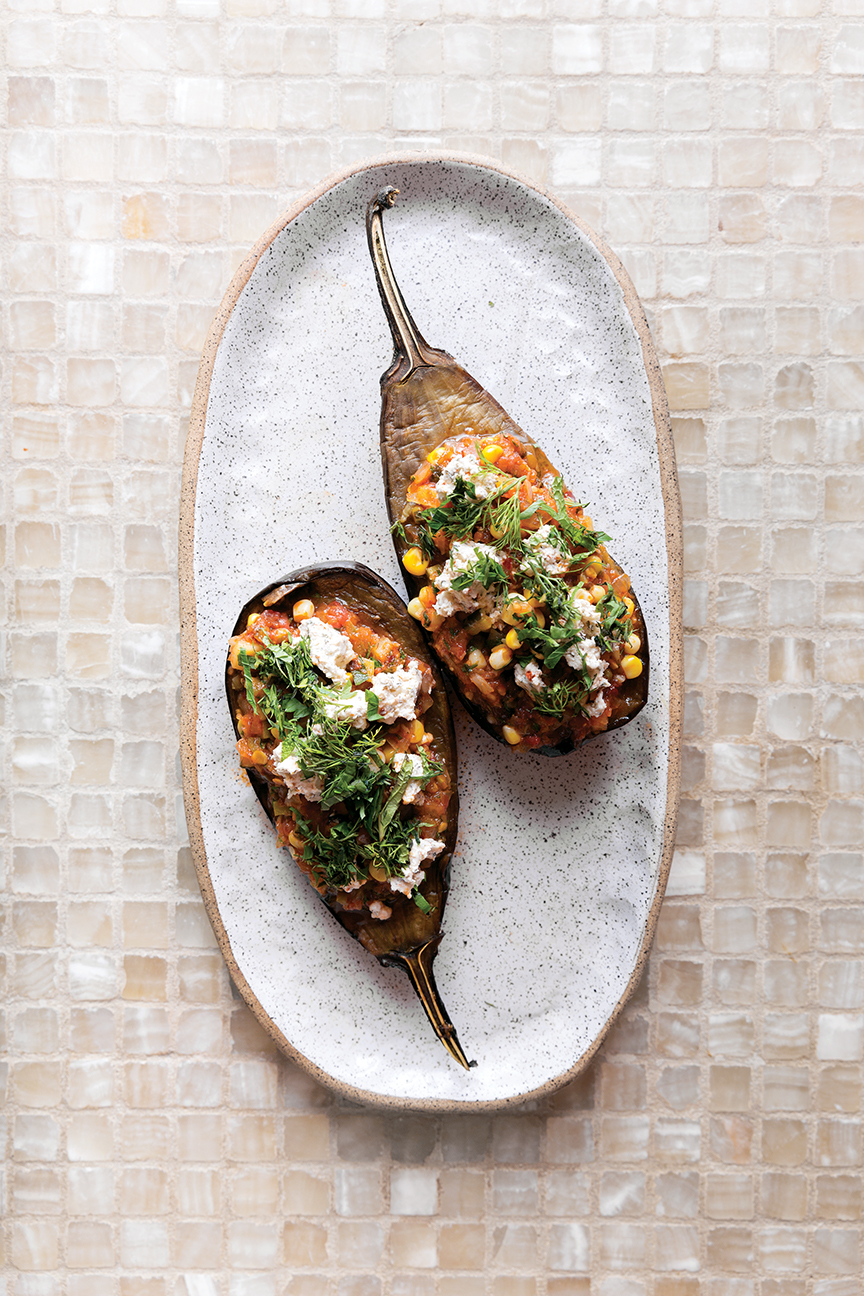
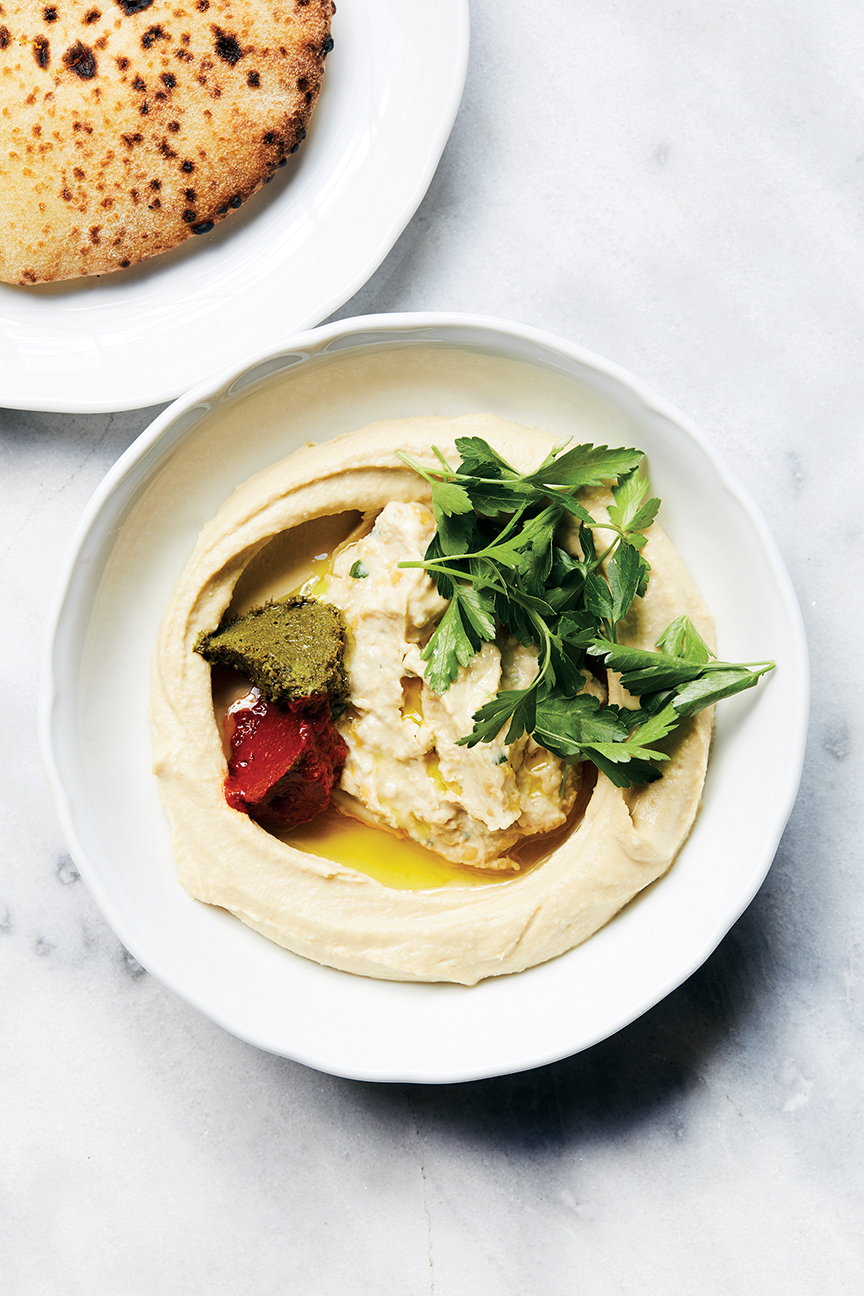
Photo by Nicole Franzen
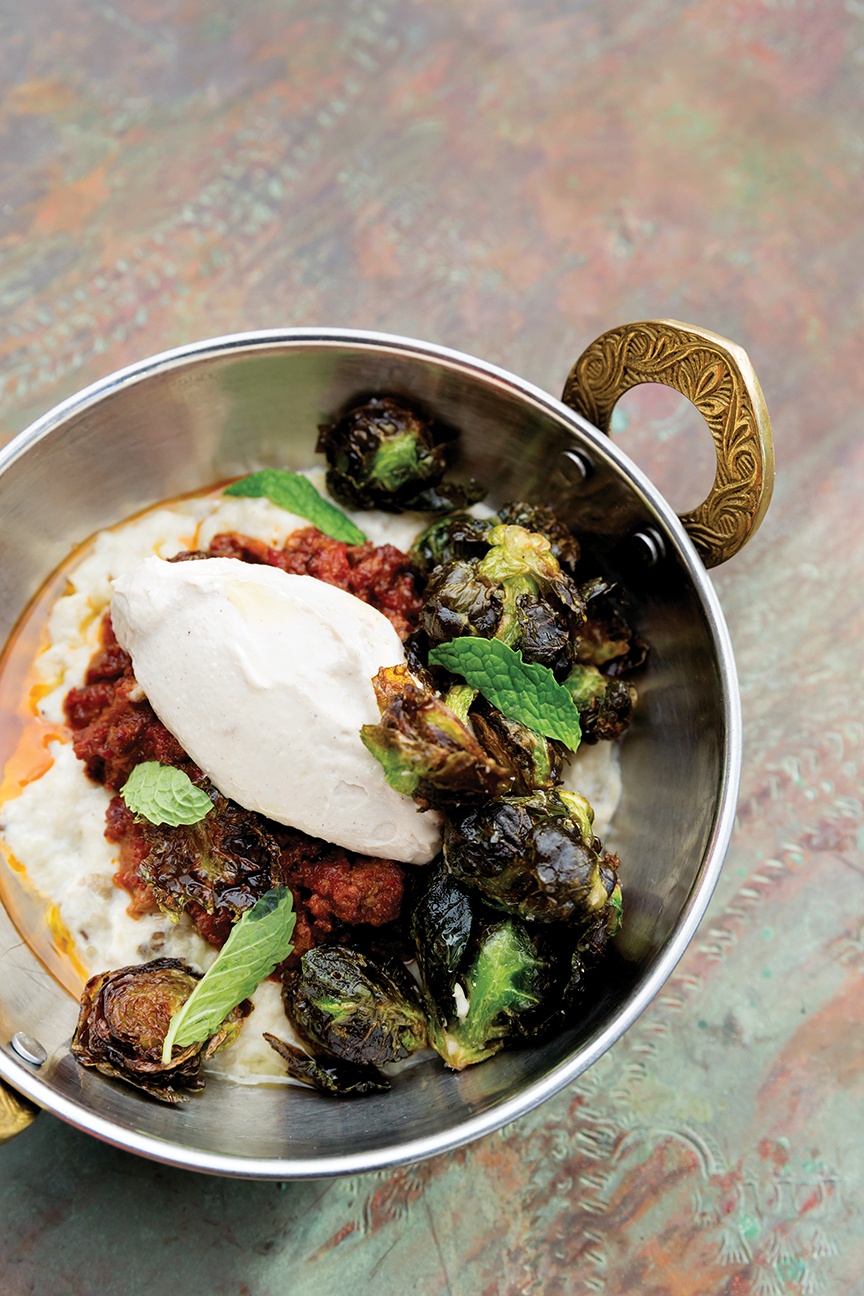
Food Photos by Kristin Teig Photography
Chef Michael Solomonov, a native Israeli who grew up in Pittsburgh, opened Zahav (“gold” in Hebrew) in Philadelphia a decade ago and has won multiple James Beard Awards for his modern Israeli cuisine. Hardly an elitist, the chef/owner is frequently found covered in flour, preparing his legendary laffa bread dough for the restaurant’s wood-burning oven. In his festive, high-ceilinged dining room, traditional lanterns hang over the bar and a photo mural of Jerusalem’s Machane Yehuda Market sets the mood.
Author of Israeli Soul and Zahav: A World of Israeli Cooking (for which he won a couple of those awards), Solomonov is pleased to introduce authentic Israeli cooking to American diners. “Zahav was our way of bringing Israeli hospitality and the soul of Israeli cooking and dining to the U.S.,” says the chef. Solomonov reports that originally the menu was very literal, concentrating on authentic Israeli dishes. “But now we’ve become more comfortable in this conduit role and the relationship that we have for being a culinary tour guide, implying Israeli food without having to copy-and-paste recipes we see over there.”
“We can’t simply call Israeli cooking ‘Middle Eastern,’” insists Solomonov, noting the diverse influences in the country, including about 100 cultures represented by Israeli residents. “We have this convergence of European, Middle Eastern and North African cuisines all happening symbiotically — that’s what makes our food Israeli,” he says.

Photo by Kristin Teig Photography
Hummus with various toppings arrives with Solomonov’s signature laffa, while other mezze include veal carpaccio with coffee-brined egg and preserved lemon, and grilled duck hearts with green garbanzos. Grilled over coals are merguez sausages, harissa-spiked hanger steak or branzino, all elevated versions of traditional dishes from Israel.
The acclaimed chef points to diversity as one of the factors contributing to the current popularity of the region’s cooking, noting that its reliance on vegetables and traditional techniques (e.g. cooking over wood) also appeal to contemporary restaurant-goers. “Diners are always looking for something new, and since there’s so much history and soul in this cuisine, I think it relates to American cooking more than people realize,” says Solomonov.
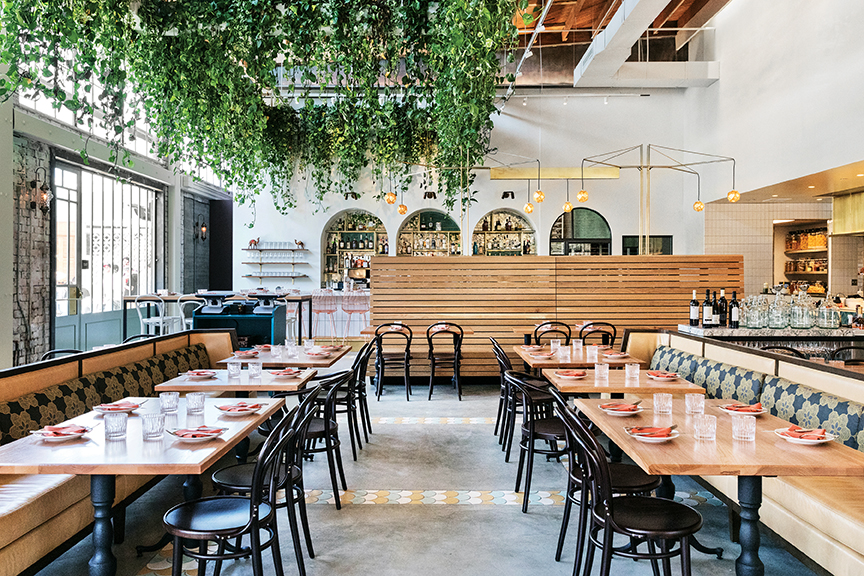
Photo by Dylan + Jeni
Bavel Los Angeles
In the Arts District in downtown Los Angeles, where crumbling factories are being transformed into chic art galleries, boutiques and bistros, young chef Ori Menashe and wife Genevieve Gergis have become prominent restaurateurs. Their first establishment, Italian-inspired Bestia, gave the Arts District culinary cred back in 2012, and this year they followed it up with Bavel, a contemporary Middle Eastern eatery.
Menashe was born in L.A., but raised in Israel, and collectively the couple also has roots in Morocco, Turkey and Egypt, so their menu at Bavel is informed by the entire region. L.A., with its large Persian and Armenian populations, is a city already accustomed to Middle Eastern cuisine, but Bavel satisfies a pent-up demand for a more sophisticated, contemporary experience. Dishes such as velvety foie gras halva, lamb tartare and grilled dorade with red charmoula delight diners.
“We always wanted to open a restaurant that showcases cuisine from our family lineage with flavors and spices we grew up with,” explains Gergis, who also serves as Bavel’s pastry chef. The couple does not believe in being limited by expectations of authenticity and is more concerned about allowing high quality ingredients to take center stage. “Everyone is always searching for authenticity, but every day in this world people are creating beautiful new works of art and delicious things to eat while only being authentic to themselves,” explains Menashe.
At Cambridge, Massachusetts’ Oleana, a mile from the Harvard campus, chef/owner Ana Sortun creates a progressive menu inspired by the cuisine of Turkey, which she fell in love with as a young chef. “The food is so rich, but nothing is heavy,” says Sortun, explaining the sophisticated use of spices in Turkish cooking is distinct from any other cuisine.
“My mission was to expand people’s perception of the Mediterranean and bring Middle Eastern cuisine into the mainstream,” says the classically trained Sortun, whose heritage is actually Norwegian. She suggests that increased travel to the region, health-consciousness and advocacy from chefs like Zahav’s Michael Solomonov are contributing to unprecedented popularity of the region’s cooking.
“I try to introduce my customers to authentic flavors, not necessarily the kind of authentic dishes I would cook if I was a native of Turkey,” says Sortun, who admits a penchant for creativity. A meal at Oleana might begin with mezze such as spinach falafel, quail kabab with a baharat spice blend, or Mediterranean deviled eggs. Larger plates include za’atar-spiced chicken with a Turkish cheese pancake or striped bass with pistachio muhammara, followed by desserts like a Turkish rendition of profiteroles.
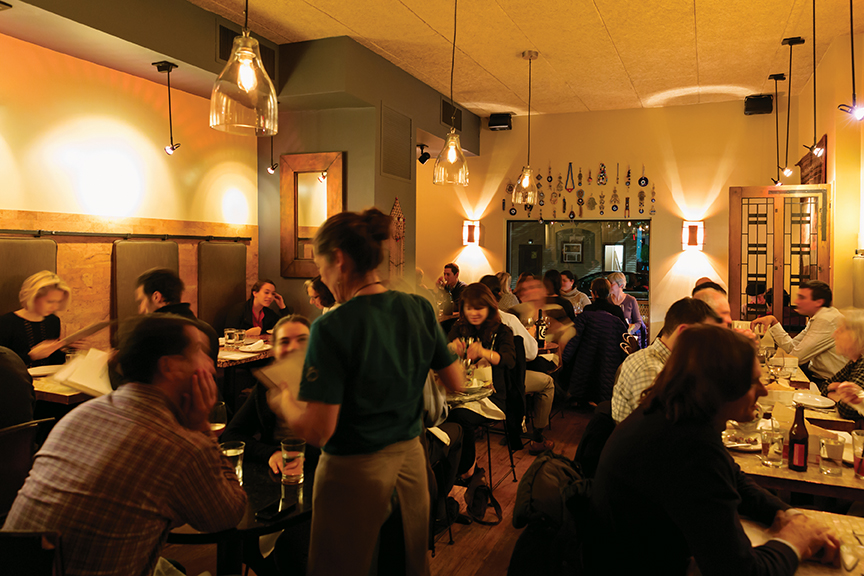
Photo by Kristin Teig Photography.
Oleana Cambridge, Massachusetts
Sortun also co-owns a casual bakery and mezze bar in Cambridge called Sofra, and Sarma in nearby Somerville where former Oleana chef Cassie Piuma presents Middle Eastern exoticism disguised as familiar American comfort foods. “We wanted Sarma to be young and accessible, with small plates and a big bar,” says Sortun, who adds, “It’s more playful, less serious than Oleana.”
Snacks at Sarma include Turkish-spiced beef jerky, brisket shawarma served taco-style, pork belly biscuit sliders layered with jalapeño-whipped feta, and a Middle Eastern riff on the iconic Philly cheesesteak. “Cassie is using language to make the cuisine at Sarma more accessible,” says Sortun, noting that expressing familiar concepts builds trust with diners.
New Orleans hardly seems the place to find exceptional Middle Eastern cuisine, but Big Easy diners are happy to take a break from gumbo and étouffée for chef Alon Shaya’s contemporary Israeli cuisine. His restaurant, Saba (“grandfather” in Hebrew), features a homey dining room and a menu that layers modern concepts over ancient traditions from the Middle East.
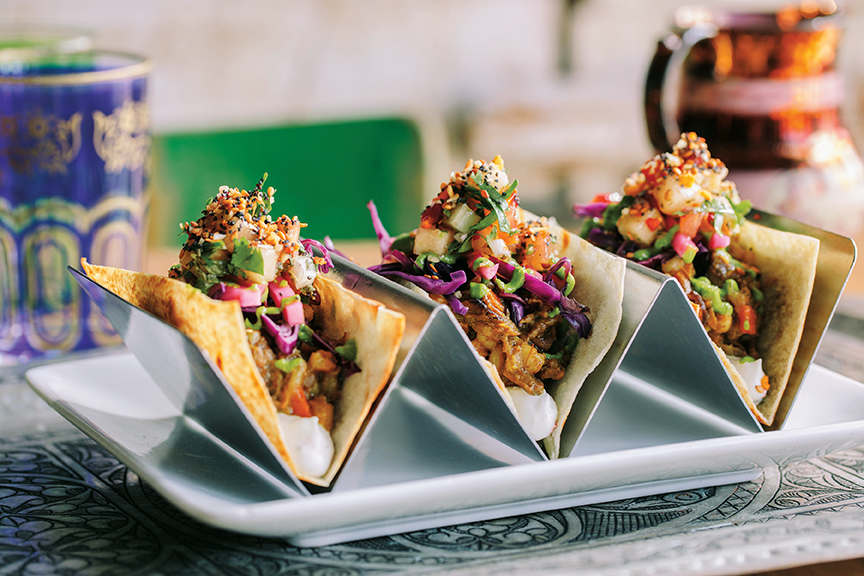
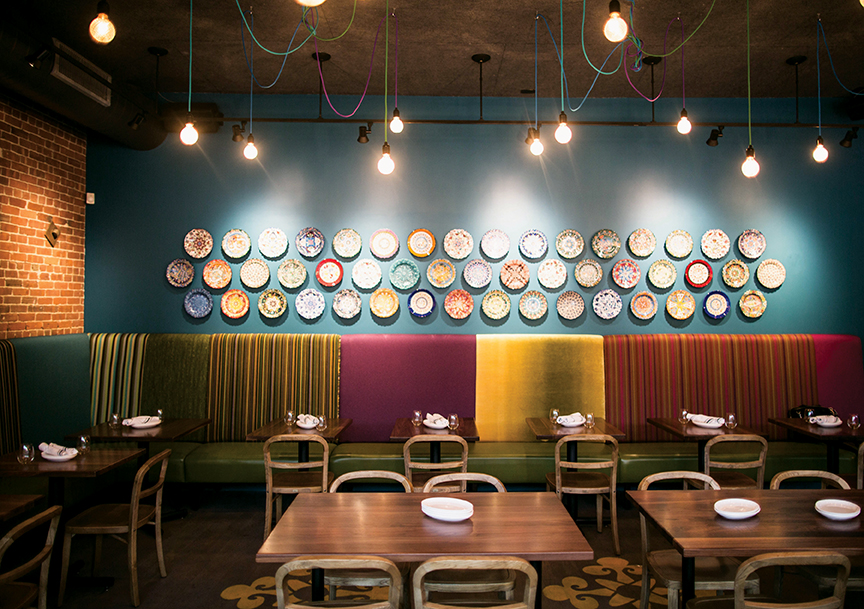
Photo by Susie Cushner.
Sarma Somerville, Massachusetts
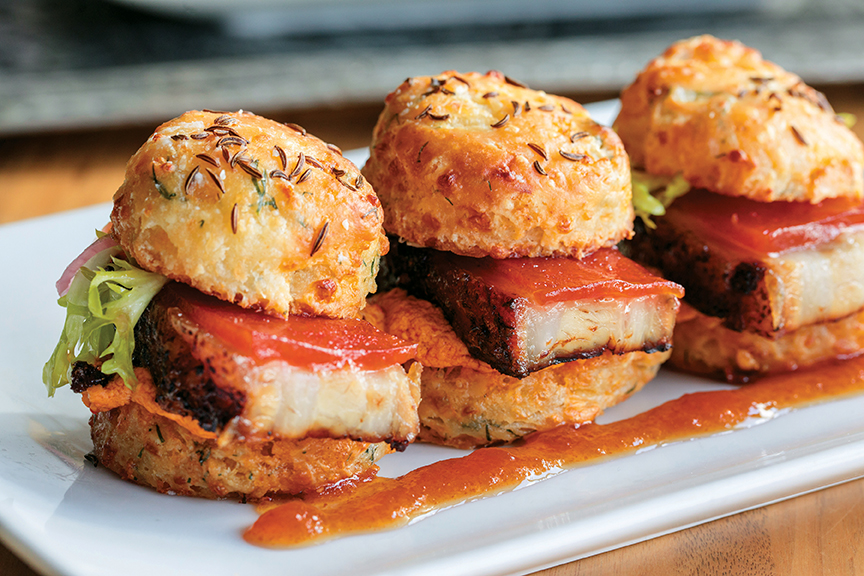
Food Photos by Brian Samuels.
At Saba, Shaya offers a selection of hummus preparations incorporating everything from spicy Brussels sprouts to blue crab, while octopus is treated with shawarma spices and foie gras is complemented with date honey and Marcona almonds. Caviar may precede family-style harissa-roasted chicken or Moroccan-inspired lamb shank pastilla.
“We don’t try to invent anything,” says Shaya, who states the restaurant’s goal is to create food that evokes memories and emotions. Concurring with Philadelphia’s Solomonov, he reports, “Israeli cuisine is different because of the immigration that occurred over the last 70 years,” with cultural influences in Israel, including Russian, Yemenite, Greek, and Moroccan. “It’s how those cuisines intermingle that make it unique,” adds the Israeli-born chef/owner.
Shaya does not necessarily subscribe to the view that Israeli and Middle Eastern cuisines are suddenly trendy. “I think it’s just good, comforting and recognizable food,” he says, adding for emphasis, “I think it’s actually anti-trendy, and that’s why so many people like it.”
Bavel Los Angeles www.baveldtla.com
Saba New Orleans www.eatwithsaba.com
Oleana Cambridge, Massachusetts www.oleanarestaurant.com
Sarma Somerville, Massachusetts www.sarmarestaurant.com
Sofia Bakery & Café Cambridge, Massachusetts www.sofiabakery.com
Zahav Philadelphia www.zahavrestaurant.com
American chefs appreciate French tradition, but are increasingly inspired by ethnic communities in their own backyards.
By Roger Grody
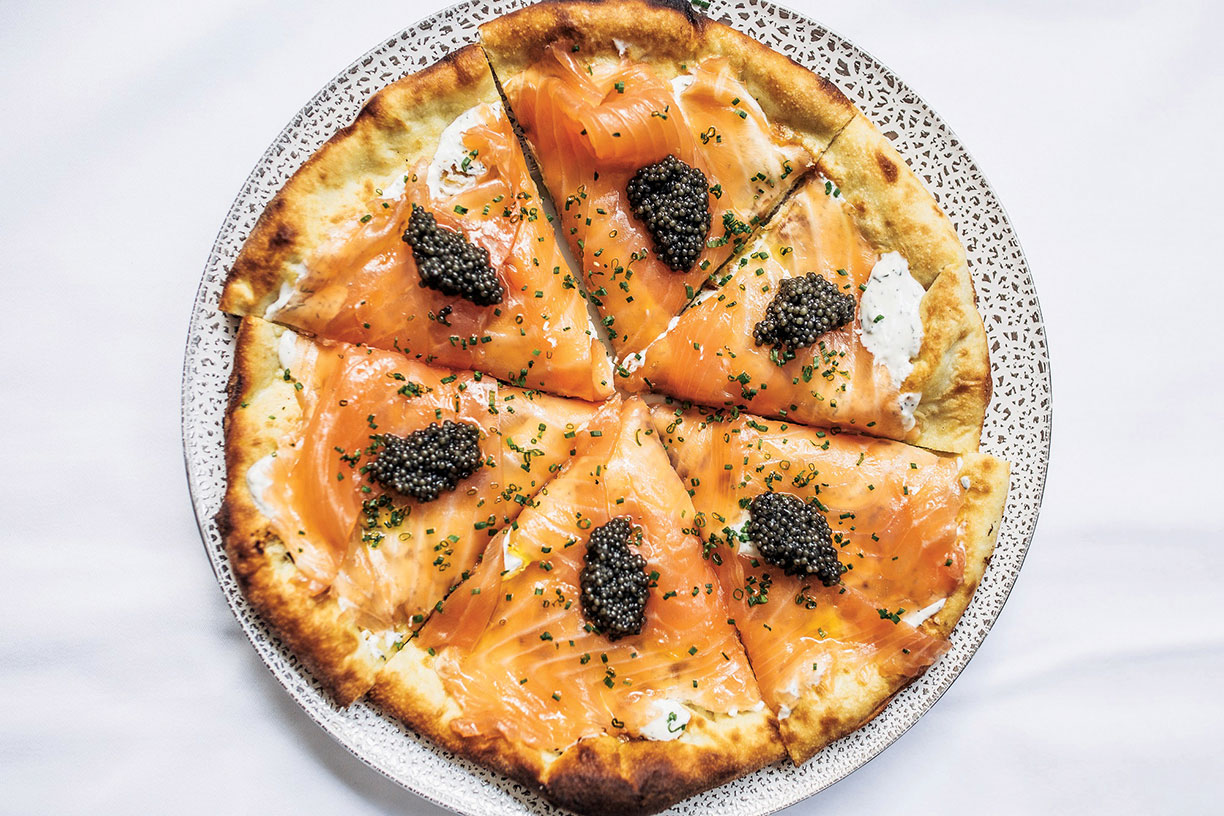
Photo courtesy Antonio Diaz
There was a time when young chefs in America were primarily influenced by French masters like Paul Bocuse or Joël Robuchon. While classic technique remains important, eclectic global flavors have become equally influential. Conveniently, chefs no longer need to travel the world to discover exotic fare, because it is simmering in the diverse ethnic neighborhoods of most American cities.
The practice of incorporating ethnic elements into familiar dishes used to be referred to as “fusion,” a term that has fallen out of favor with contemporary chefs, and today’s cross-cultural combinations are more nuanced and less frivolous than in the 1980s. Today, chefs tend to use local ethnic cuisines as accents or pay tribute to their own families’ immigrant roots. The presence of Middle Eastern falafel on a French menu or a dusting of Japanese togarashi seasoning on potatoes at an all-American steakhouse does not compromise the integrity of their respective cuisines, but certainly makes them more interesting.
A master of infusing local ethnic flavors into his dishes is celebrity chef José Andrés, who borrows Latin American and Asian elements at The Bazaar by José Andrés in Los Angeles. In multicultural Miami, he incorporates Caribbean elements into his menu at The Bazaar South Beach. Given his own Spanish heritage, incredible versatility and expertise with complex molecular gastronomy techniques, most Andrés menus feature some unusual culinary mashups.
At South Beach, Andrés honors the local Cuban community with colada Cubana, a play on Cuban coffee turbocharged with foie gras, and pollo al ajillo (garlic chicken) slow-cooked with black garlic. As a tribute to South Florida’s Jewish community — largely comprised of transplanted New Yorkers — the chef offers a clever riff on bagels and lox: dill cream cheese-filled bagel cones topped with salmon roe. And for dessert, Andrés playfully deconstructs another local specialty, Key lime pie.
Bazaar South Beach chef de cuisine Tito Vargas, a native of Puerto Rico, says he and Andrés draw inspiration from a wide variety of Latin American and Caribbean cultures. “It’s important that I keep true to José’s vision, showcasing the main ingredient and transforming it without sacrificing the flavor and integrity of the product,” he says. Vargas notes that even when applying high-tech culinary tricks, the essence of a dish is respected and preserved. “In no way, shape or form does it look like a Cuban sandwich, but when you bite into it you get all the flavors that compose a Cuban sandwich in a more fun, inventive way,” says the chef of The Bazaar’s molecular gastronomic version.
Despite Los Angeles’ reputation as a bland, immense swath of suburbia, its location — on both the Pacific Rim and threshold to Latin America — ensures diverse ethnic communities that constantly fuel the imagination of local chefs. In L.A., where California Cuisine has morphed into a more global fare, crossing culinary borders is almost routine. At Wolfgang Puck’s celebrity-favored Spago in Beverly Hills, for instance, the menu includes elements from nearly a dozen cuisines.
Bryant Ng was trained in classic French cuisine — he cooked with celebrated chef Daniel Boulud in New York — but at his own restaurant, Cassia in Santa Monica, California, he cooks French brasserie fare with an ethnic twist. At first glance, Cassia’s menu looks like it was borrowed from a Parisian brasserie, but the young chef tweaks traditional dishes with accents from his father’s Singaporean roots and his wife’s Vietnamese heritage.
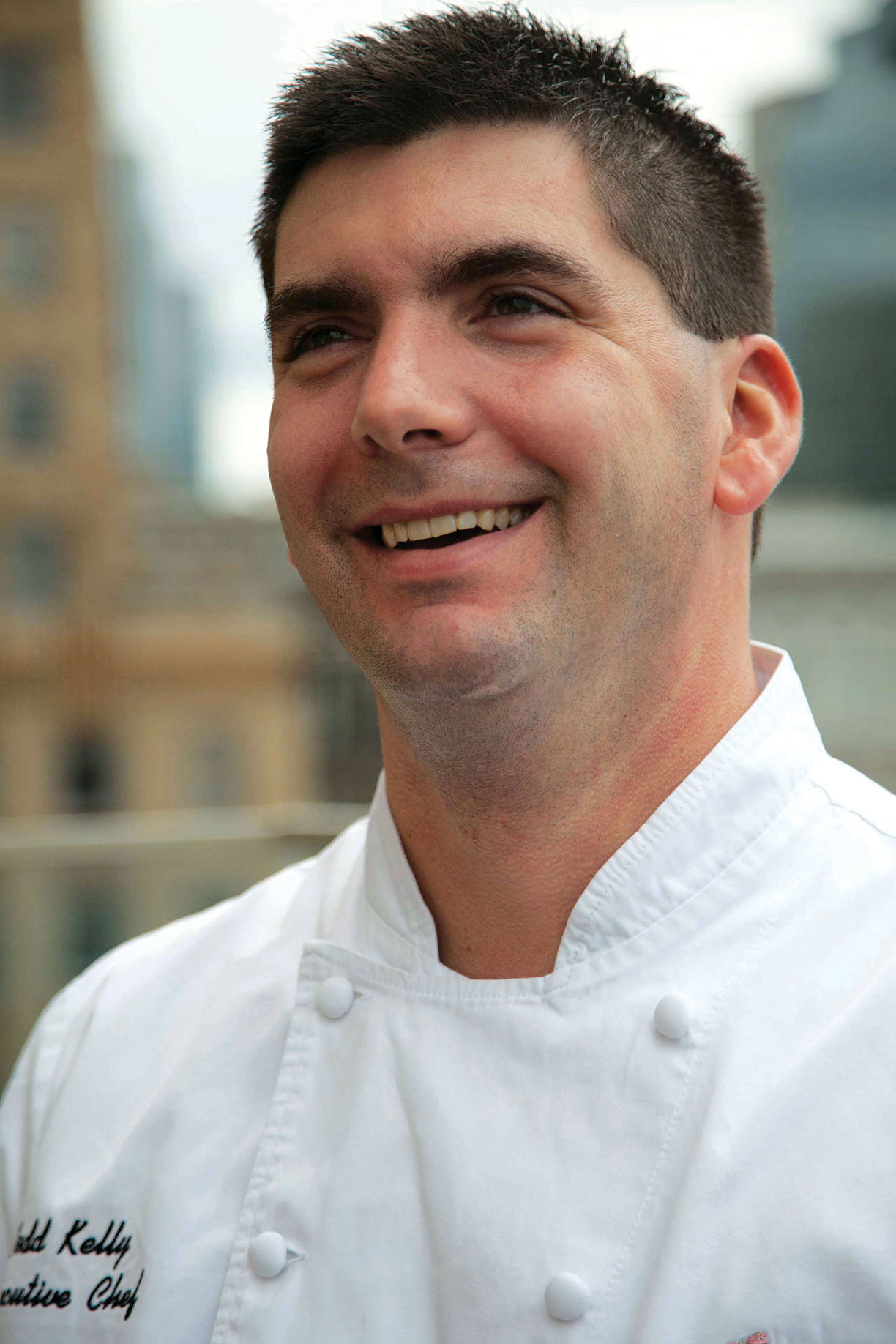
Todd Kelly
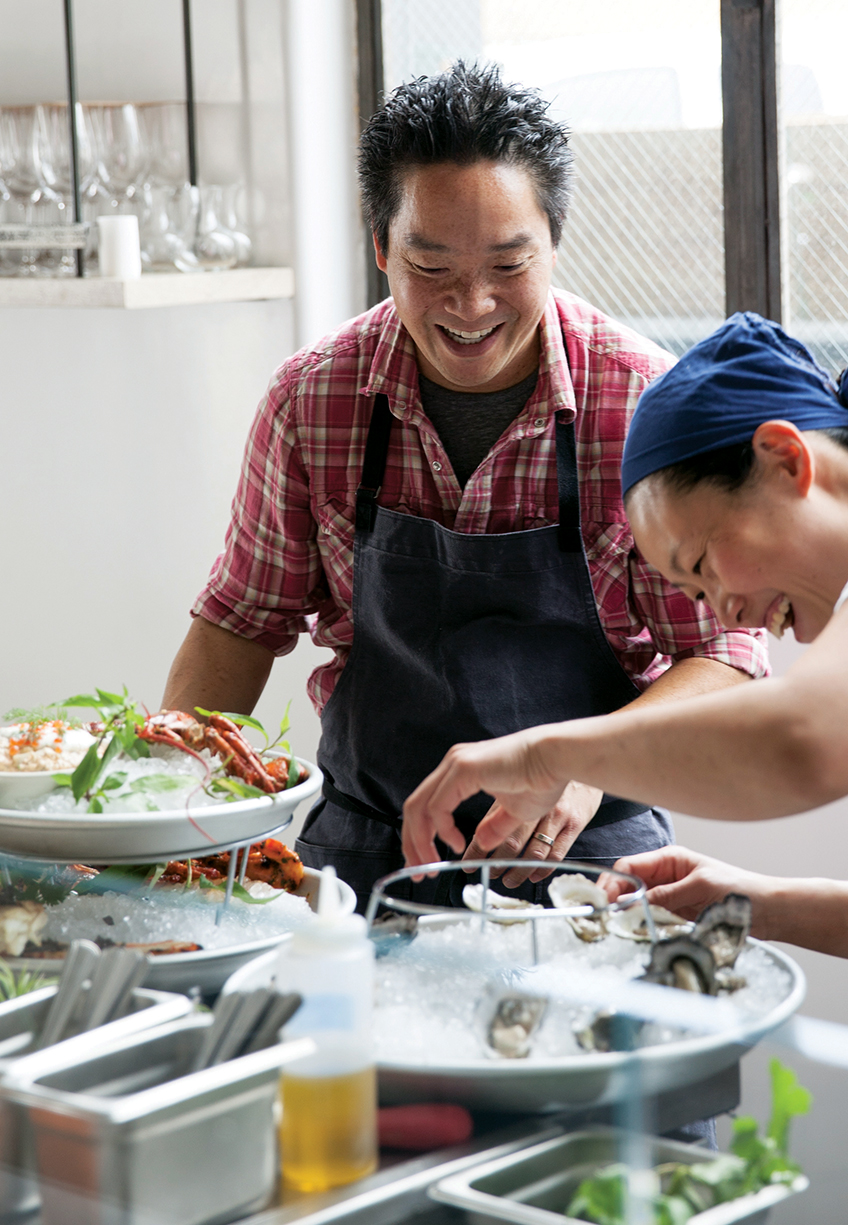
Bryant Nig
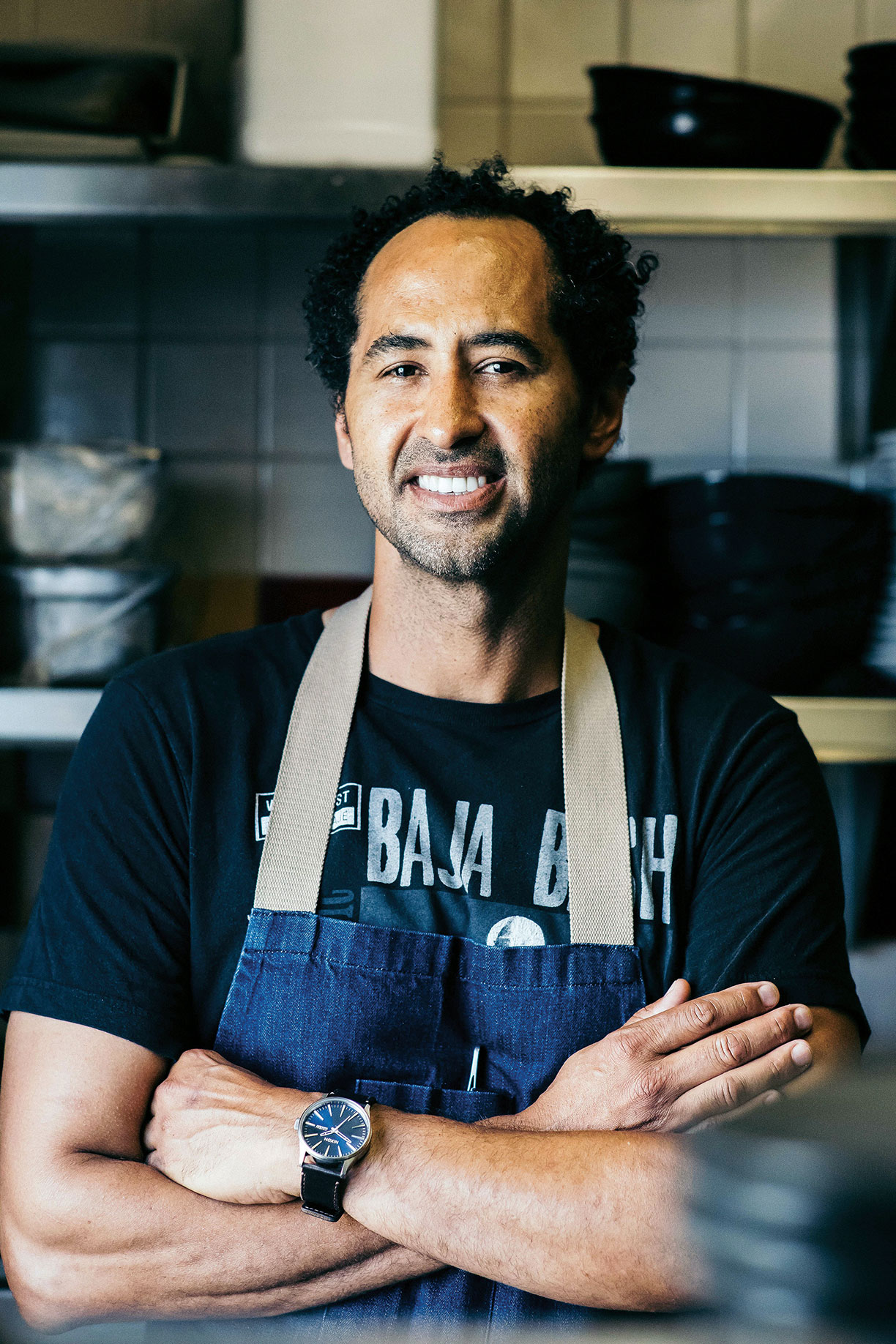
Jason Nibb
Ng’s charcuterie platter includes items like Singaporean candied pork and Vietnamese meatloaf, while escargots are scented with lemongrass. Cassia’s take on the French comfort dish of pot-au-feu has a pho-inspired broth and the bistro staple of steak frites is bathed in a Phú Quôc Island peppercorn sauce. Kaya toast, a signature of Singapore’s street vendors, is not likely to be found in a 14th arrondissement brasserie, but is a specialty at Cassia.
“It’s a very personal menu because it combines the food of my heritage, but also has influences from my professional experiences,” explains Ng. “Understanding the ‘soul’ of a cuisine is the greatest challenge,” says the chef, who dismisses the practice of simply adding a single indigenous ingredient. “Trying to incorporate multiple culinary influences requires a lot of self-editing and discipline,” adds Ng, who believes any composition must respect the referenced cultures.
Anita Lo is one of New York’s most honored chefs and her restaurant Annisa is a reflection of the diverse influences inherent in contemporary American cuisine. A second-generation Chinese-American, Lo’s passion for food can be traced to Paris, where she first fell in love with the art of cooking. She polished her skills in revered French kitchens and classic technique has always been essential to her approach.
At her Manhattan restaurant, those French sensibilities are applied to some ingredients from her own family’s heritage, as well as other global influences discovered in New York’s rich patchwork of ethnic neighborhoods. Since Annisa’s opening in 2000, Chinese dumplings filled with foie gras mousse and jicama have been one of Lo’s signature dishes. A Chinese-French mashup way too cool to be called “fusion,” the dumplings are topped with seared foie gras and a beguiling black vinegar reduction.
At Orchids at Palm Court, an opulent dining room in the Art Deco Hilton Cincinnati Netherland Plaza, executive chef Todd Kelly is contributing to getting the food scene of the Midwest — a region often neglected outside of Chicago — noticed. As a boy, the native New Yorker lived in Mauritius, an island in the Indian Ocean near Madagascar, and that experience, as well as the chef’s naturally curious palate, results in a menu with eclectic influences.
Kelly’s cuisine, built on a solid classical foundation, is laced with intriguing ingredients like Buddha’s hand, lemongrass, paneer, and sudachi. He is adept at making familiar preparations suddenly exciting without excessively altering their essence. For example, a dash of harissa (a spicy North African chili paste) gives a dish of white asparagus with traditional French velouté sauce some zing, while red snapper en papillote, a characteristically South of France preparation, receives an exotic Indian accent with vadouvan curry.
“I like to pull in flavors from my past or things I really crave,” says Kelly, noting that the cultural melting pot of Mauritius and ethnic neighbors on Long Island both contributed to his culinary wanderlust. Recently, the chef has been experimenting with Indian ingredients like nigella, fenugreek and mango powder, insisting they need not distract from the classical roots of a recipe. “The lesson is all about balance and learning that sometimes it’s the simplicity and restraint that controls a dish,” says Kelly.
In La Jolla, San Diego’s chic oceanfront district, executive chef Jason Knibb is known for his molecular gastronomy and globetrotting flavors at Nine-Ten Restaurant & Bar, which celebrates the Golden State’s finest seasonal ingredients. His Jamaican heritage may account for the jerk-seasoned pork belly on the chef’s menu, but his ethnic influences also extend to Latin American, Japanese and Middle Eastern traditions.
“San Diego is a tapestry of rich ethnic diversity, and the local food scene is no exception,” says Knibb. “There are so many chefs who have come to town from other regions bringing their own ethnic influences,” he adds, and makes a point to experience their cuisines firsthand. As a young chef in San Francisco, Knibb lived next door to a quick-service Mediterranean restaurant, and says, “They had some of the best falafels I’ve ever had … I still crave them today.” That unpretentious Mission District eatery was the inspiration for Nine-Ten’s spice-roasted carrots and carrot falafel with harissa yogurt and carrot hummus.
The recently announced James Beard Awards — the Oscars of the restaurant business — reflect a renewed respect for ethnic inspirations. The big winners were Israeli-American chef Michael Solomonov of Philadelphia’s Zahav and Chicago’s Topolobampo, where celebrity chef/restaurateur Rick Bayless is energized by his frequent travels to Mexico.
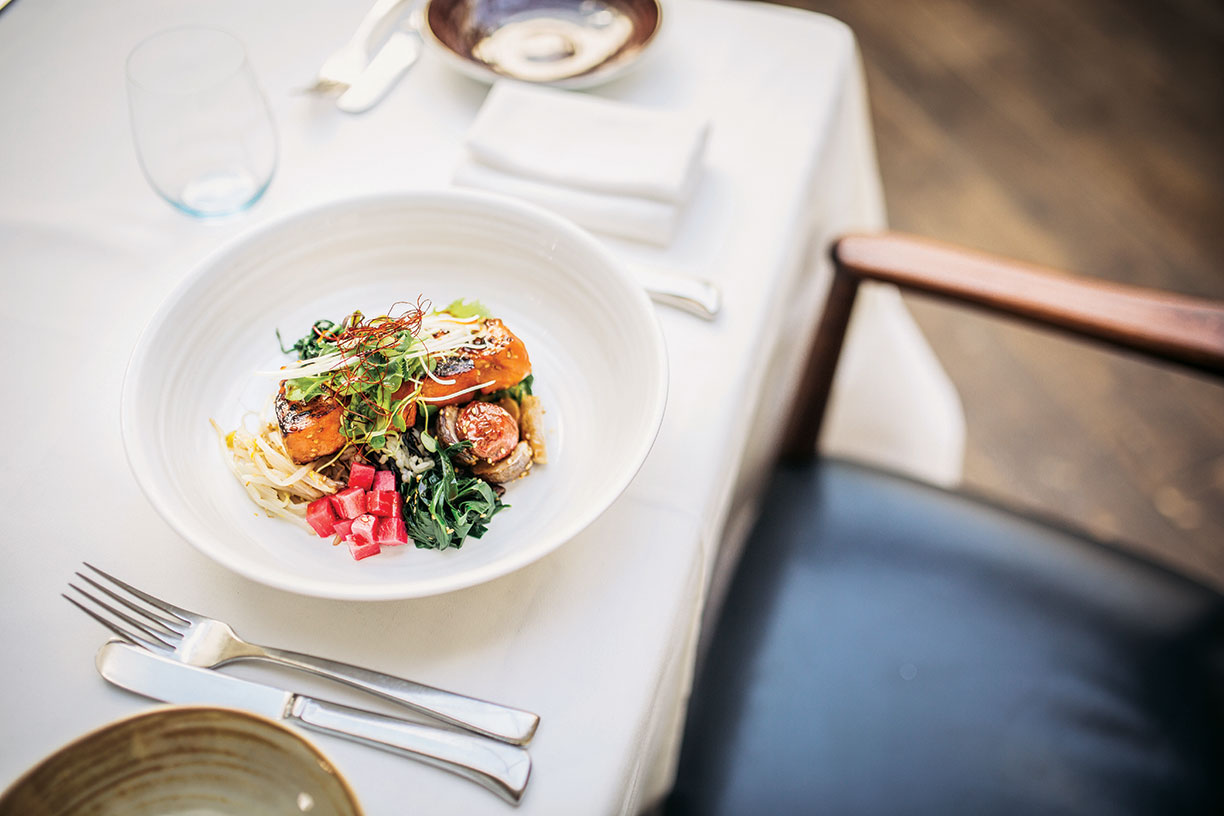
Photo courtesy Antonio Diaz
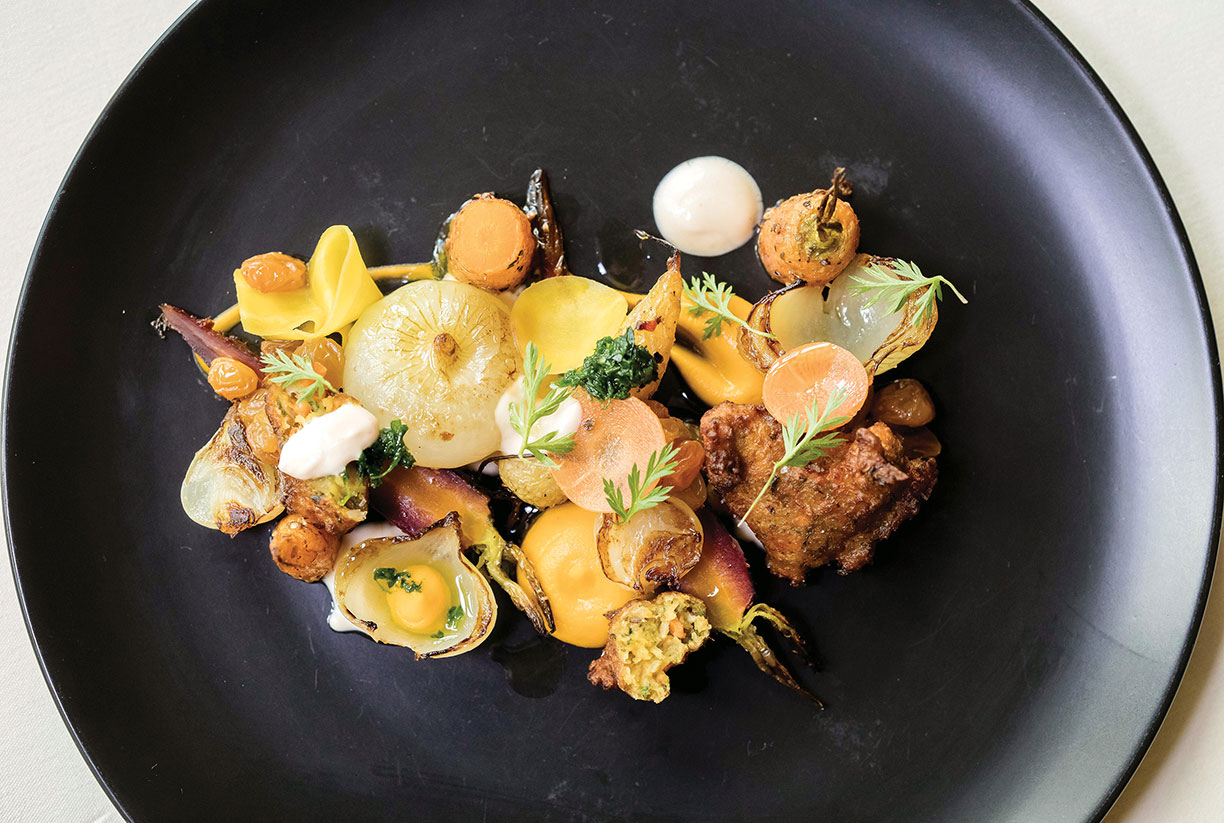
Photo courtesy Jason Knibb
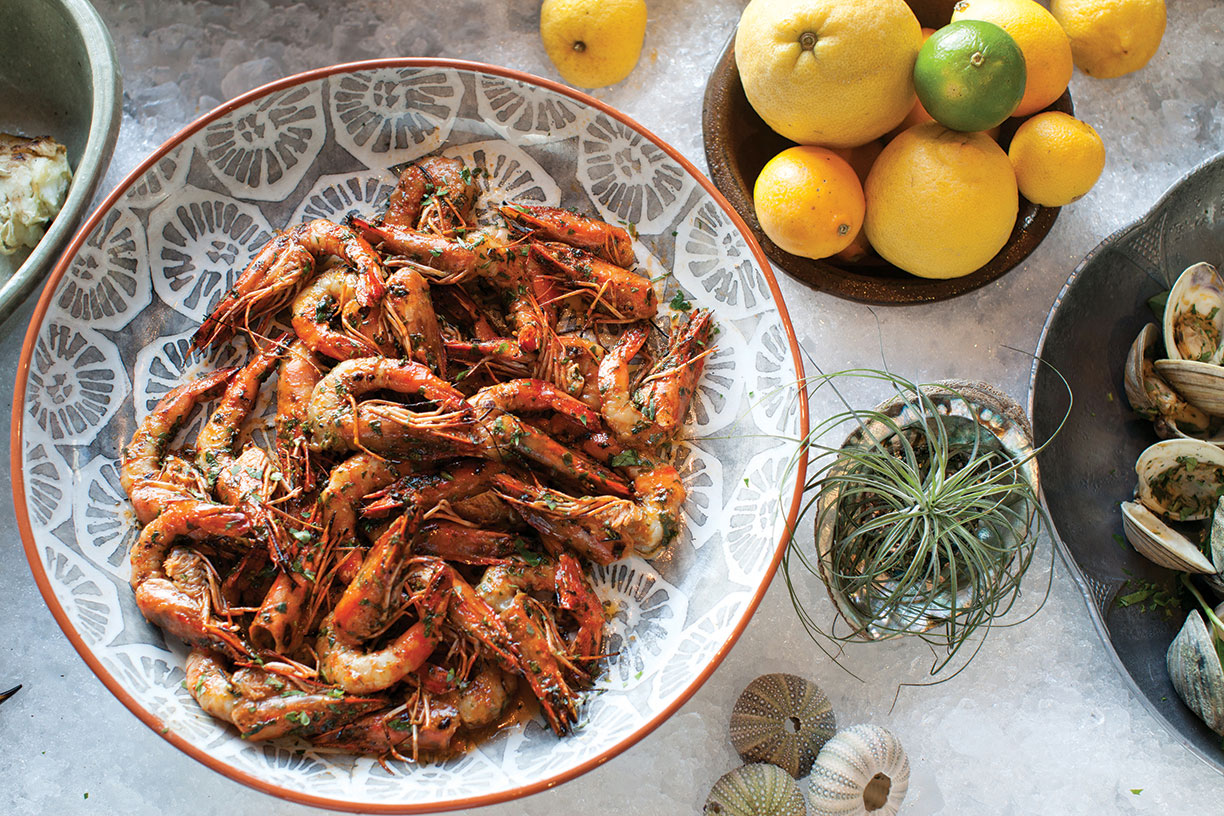
Photo courtesy Rick Poon
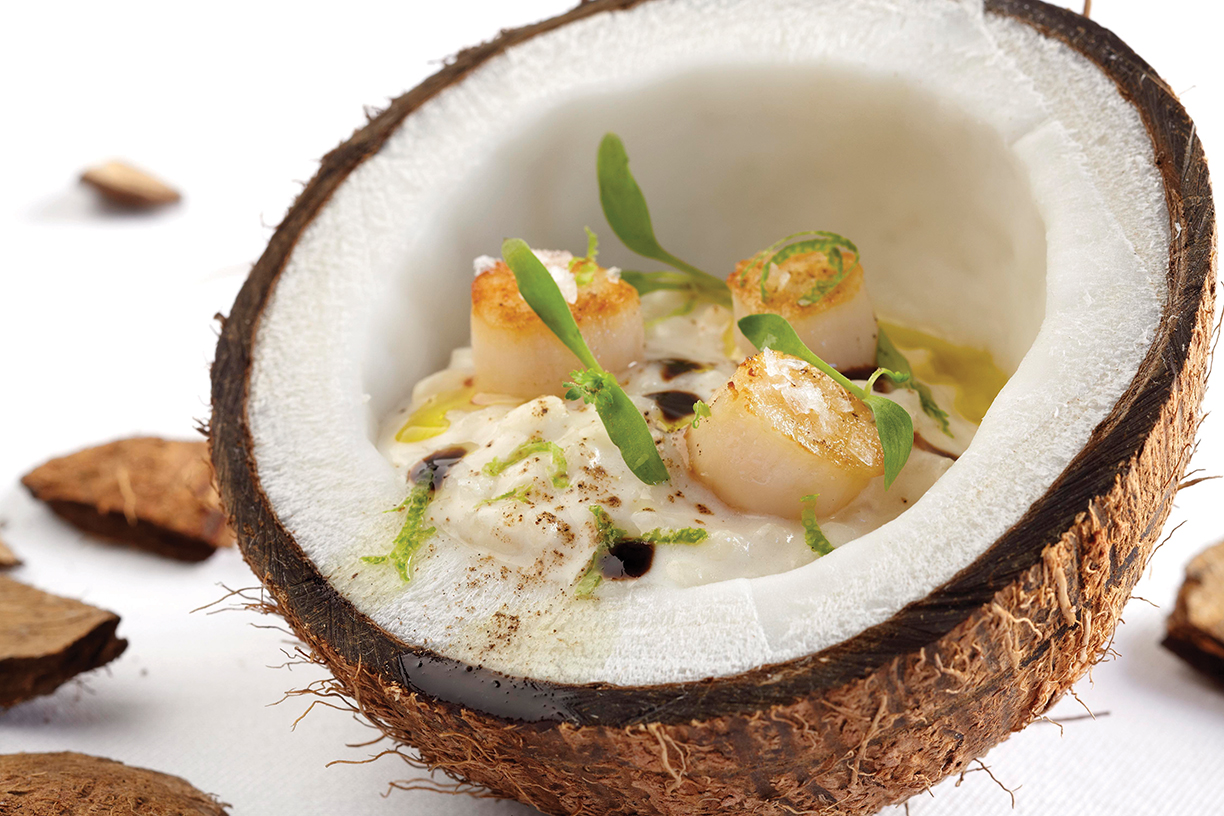
Photo courtesy Greg Powers Photography
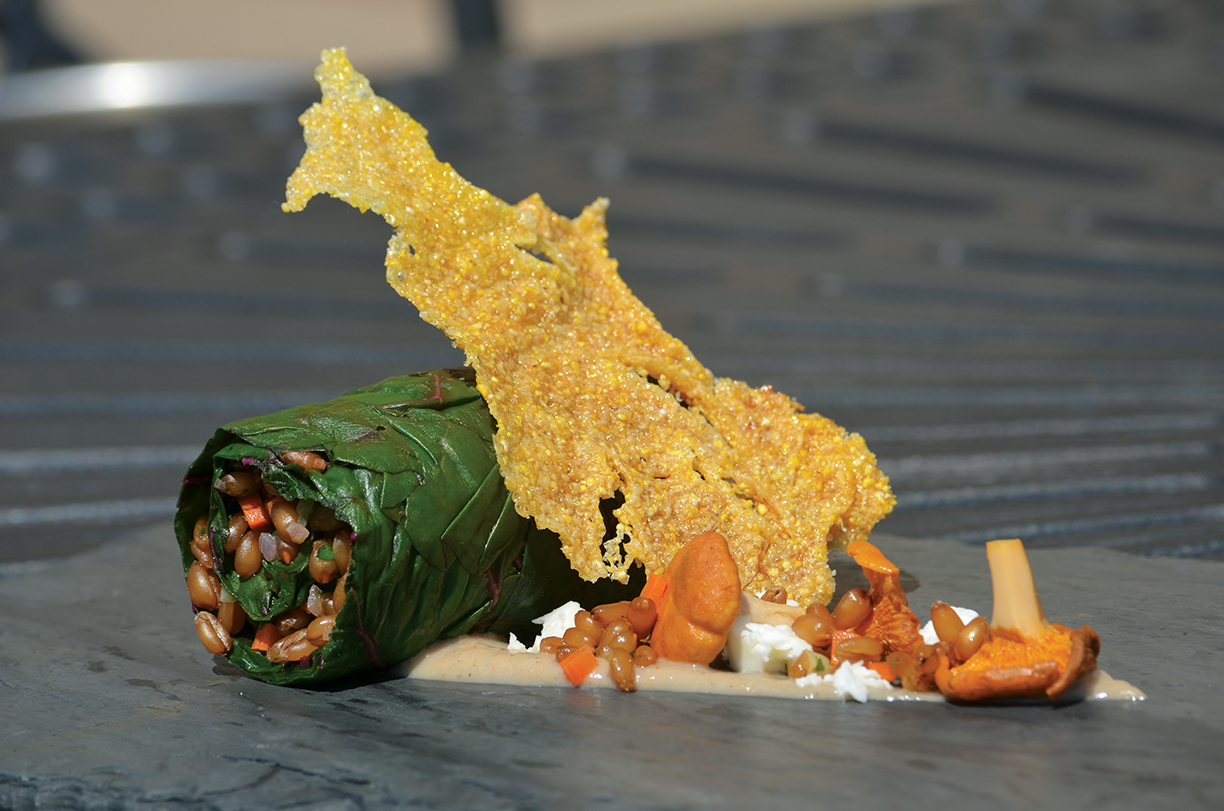
Photo courtesy Todd Kelly
Global Influences
Annisa, New York; www.annisarestaurant.com
The Bazaar by José Andrés, Los Angeles; www.sbe.com
The Bazaar by José Andrés South Beach; www.sbe.com
Cassia, Santa Monica; www.cassiala.com
Orchids at the Palm Court, Cincinnati; www.orchidsatpalmcourt.com
Nine-Ten Restaurant & Bar, San Diego; www.nine-ten.com
Spago, Beverly Hills; www.wolfgangpuck.com
Topolobambpo, Chicago; www.rickbayless.com
Zahav, Philadelphia; www.zahavrestaurant.com














